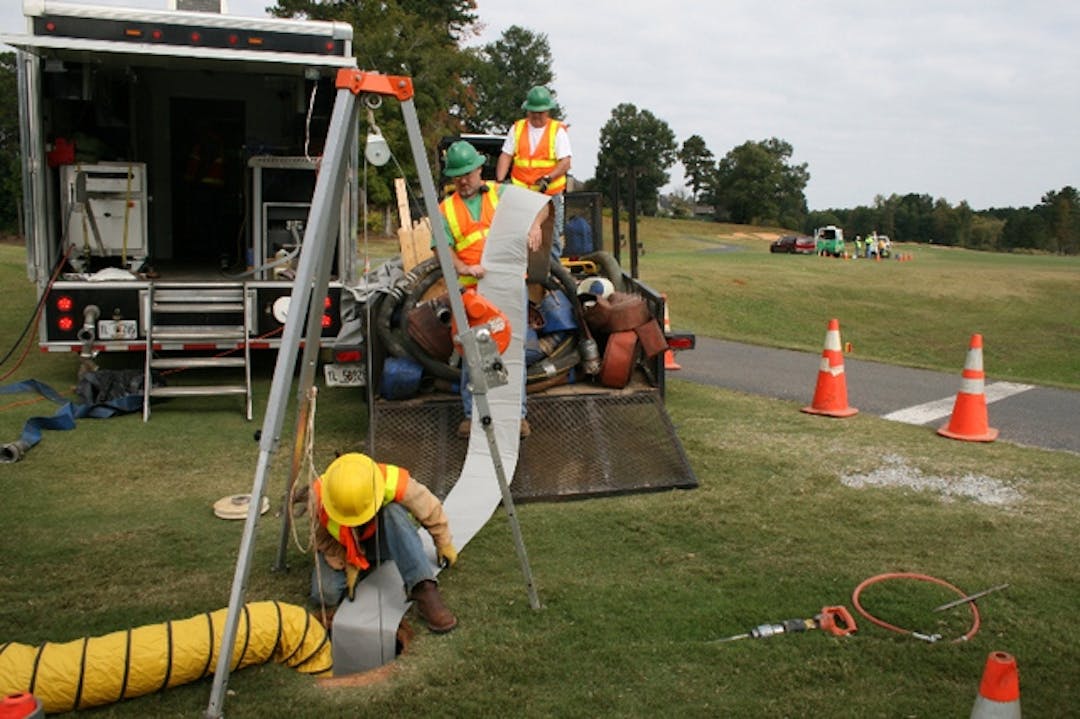Share Inflow and Infiltration and Wastewater Overflows on Facebook
Share Inflow and Infiltration and Wastewater Overflows on Linkedin
Email Inflow and Infiltration and Wastewater Overflows link
Inflow and Infiltration (I&I) occurs when stormwater and groundwater enter sanitary sewer systems. In general, I&I issues are related to improperly cross-connected stormwater collection pipes, and the age of sewer systems, which deteriorate and allow groundwater intrusion into the sewer over time.
I&I becomes a problem in sewer systems by exceeding the capacity of the system to convey and/or treat the high volume of clean rain or groundwater that infiltrates the sewer during wet winter months and rain events. When this capacity is exceeded, the excess flow of mixed stormwater and wastewater overflows to the marine environment at various emergency discharge points. The system is designed to overflow under these conditions to prevent major damage to infrastructure.
Share Proposed Updates to the Plan on Facebook
Share Proposed Updates to the Plan on Linkedin
Email Proposed Updates to the Plan link
The key changes to the Section 5 Goals and the CRD commitments are to:
- Clarify efforts to reduce sub-five-year return period overflows on an appropriate timeline. The proposed approach of reducing and eliminating overflows during sub-five-year storm events is intended to be a practical solution that meets regulatory requirements while ensuring long-term environmental protection.
- Complete a study assessing the impacts of storm event overflows from the Clover Point long outfall.
- Assess storage and treatment options to reduce overflows caused by I&I at the Clover Point outfall.
- Create a mass balance model/tool to assess, document and improve the effectiveness of the CRD and municipal asset management plans for eliminating overflows at the Clover Point long outfall by 2045.
The key changes to participant (local governments) commitments are to:
- Prepare drainage improvement plans for those areas where building foundation drains are unable to connect to the storm drainage system.
- If sanitary sewer flows exceed allotted flows in Bylaw 4304, consider implementing private sewer lateral replacement bylaw to replace laterals that have exceeded their service life and separate combined storm and sanitary sewer connections.
Share Environmental Risks of Wastewater Overflows on Facebook
Share Environmental Risks of Wastewater Overflows on Linkedin
Email Environmental Risks of Wastewater Overflows link
Underground sewer and stormwater pipes deteriorate over time. They require periodic inspection and maintenance to maximize their service life. Failing pipes can result in:
- Basement flooding which is expensive, disruptive and damaging to personal belongings.
- Sewage leaking to the environment.
- Rainwater and groundwater mistakenly draining to the sanitary sewer system (referred to as inflow and infiltration), which can result in sewer overflows and beach closures.
The CRD and member municipalities proactively inspect and maintain their pipes. It’s recommended that home owners also take action by periodically having their pipes inspected by camera and maintained as required. Learn more about maintenance of underground pipes.
The Municipal Wastewater Regulation stipulates that overflows must not occur, unless during a storm with greater than five-year return period. The Clover Point outfall is the only remaining location in the Core Area wastewater system that does not meet this requirement, excluding Oak Bay combined sewers, which are being managed separately. Currently, Clover Point overflows are predicted to occur for approximately 60 hours per year during the eight largest winter storm events. These overflows consist of highly dilute sewage mixed with rainwater, are generally short in duration, and are predicted to represent a very low risk to the marine receiving environment. One of the CRD commitments in Amendment 13 will be to complete a study assessing the impacts of storm event overflows from the Clover Point long outfall.
Share CRD's Inflow and Infiltration (I&I) Program on Facebook
Share CRD's Inflow and Infiltration (I&I) Program on Linkedin
Email CRD's Inflow and Infiltration (I&I) Program link
The Core Area Inflow & Infiltration (I&I) program provides educational services to the public and technical support to municipalities to help promote the reduction of the amount of rainwater and groundwater entering the sanitary sewer system.
The goals of the program are to:
1. Comply with regulatory requirements regarding I&I
2. Promote the inspection and repair of private property laterals through education
3. Prioritize I&I reduction work required to eventually eliminate overflows from the system
4. Support sewer asset management programs
5. Support efforts to maintain sewer capacity needed for future growth, densification, and climate change
Learn more about the CRD's I&I program at www.crd.bc.ca/pipes
Share What has been done to date? on Facebook
Share What has been done to date? on Linkedin
Email What has been done to date? link
The CRD formed a Technical Working Group with municipal engineers in early 2022 to develop a list of proposed changes to Section 5. A Technical and Community Advisory Committee (TCAC) was formed in October 2023 to assist the Core Area Liquid Waste Management Committee and the CRD Board with amendments to the CALWMP.
As part of the TCAC process, Kerr Wood Leidal Associates Ltd. (KWL) reviewed the 2022 proposed changes, options regarding amendments to Section 5 and has worked with staff and the TCAC to make recommendations in a report.
At the February 13, 2024 meeting, the TCAC reviewed and provided final comments on the proposed new Section 5 of the Core Area Liquid Waste Management Plan and the KWL report, expressing their support for both.


